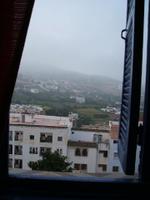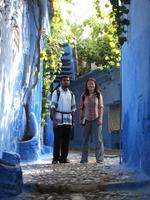Aug 16 - Chefchaouen
 The names of most places are usually meant to be pronounced as if reading from French. Chefchaouen is Sheff-shauw-in (where 'shauw' rhymes with 'how') but is often referred to by Moroccans as simply Chaouen (shauw-in). Tour groups don’t go to Chaouen. It’s a smaller town set in the hills that is popular with backpackers as a quiet rest-stop where you can recover from the heat and bustle of the imperial cities. Charming, peaceful and friendly can all be safely used in the same sentence as Chaouen. There’s no hassle, the hills are relatively cool and there’s no hurry to go see this, that or the other monument. We could not have asked for a gentler introduction to Morocco.
The names of most places are usually meant to be pronounced as if reading from French. Chefchaouen is Sheff-shauw-in (where 'shauw' rhymes with 'how') but is often referred to by Moroccans as simply Chaouen (shauw-in). Tour groups don’t go to Chaouen. It’s a smaller town set in the hills that is popular with backpackers as a quiet rest-stop where you can recover from the heat and bustle of the imperial cities. Charming, peaceful and friendly can all be safely used in the same sentence as Chaouen. There’s no hassle, the hills are relatively cool and there’s no hurry to go see this, that or the other monument. We could not have asked for a gentler introduction to Morocco.Peaceful is a relative term though. I have trouble sleeping that night because there are people enjoying their evening on the streets outside our window. For whatever reason, what seems to be a procession of cars winds its way down a nearby hill, honking all the way. Early in the morning, a rooster crows, and continues crowing - it never stopped. At daybreak, the first call to prayer also sounds out from the mosque (it sounds like someone chanting in Arabic). This is the first time I hear the call to prayer, but it will to become a regular part of the sounds of Morocco. In Europe, it was church bells and carillons that dominated the airwaves every 15 minutes; in Morocco, the call to prayer goes out 5 times daily and can be heard from the loudspeakers on all the mosques.
Our hotel breakfast consisted of mint tea (our first) and soft french bread, accompanied by butter and a runny orange jam. Our first order of business was to check bus schedules to Meknes for later in the day, so we walk down a steep hill to the bus station. There is a bus leaving around 2, so we plan to come back with our suitcases around 1. Now to explore the medina (old part of town).
 One of the other chief attractions of the town is its blue-washed streets and buildings. Doors, walls, steps, streets are all painted shades of blue ranging from a darker chalky blue to an almost blinding white. We spend a while winding through the streets, getting lost, but not caring too much.
One of the other chief attractions of the town is its blue-washed streets and buildings. Doors, walls, steps, streets are all painted shades of blue ranging from a darker chalky blue to an almost blinding white. We spend a while winding through the streets, getting lost, but not caring too much.  We end up at one of the gates through the wall enclosing the city. Beyond is a natural water source where people bring their washing and livestock for water.
We end up at one of the gates through the wall enclosing the city. Beyond is a natural water source where people bring their washing and livestock for water. A hill road leads from here to a ruined mosque, originally built by the Spanish but never used by the locals. As we walk, we pass goatherds, and two people singing a duet of some sort across the hills. (I don’t know what language it was.) At the mosques some random youths are hanging around and we talk with them a bit in French. They ask if we smoke (this area is really famous for kif) and offer to take us on a hike through the region for 200Dh to see the ‘cascades’ and the marijuana plants. We decline and climb up the minaret of the mosque to catch a view of the hills.
A hill road leads from here to a ruined mosque, originally built by the Spanish but never used by the locals. As we walk, we pass goatherds, and two people singing a duet of some sort across the hills. (I don’t know what language it was.) At the mosques some random youths are hanging around and we talk with them a bit in French. They ask if we smoke (this area is really famous for kif) and offer to take us on a hike through the region for 200Dh to see the ‘cascades’ and the marijuana plants. We decline and climb up the minaret of the mosque to catch a view of the hills. Heading back to the town, we are invited into our first carpet shop where K and I actually end up buying carpets, as A is ‘shocked and appalled’ that we do so before shopping around. I’ll write more on the little piece of drama that carpet selling is later. I regret not going back to take a picture inside the shop now. We then eat our first traditional Moroccan meal complete with tajines, OJ and stray cats. The stray cats were not in the dishes, but rather hanging around the tables and meowing at our feet for food (see lump under table in pic). They’re everywhere in the streets of this town, and as we are to discover, always hanging around the outdoor seating area of restaurants all over the country.
Heading back to the town, we are invited into our first carpet shop where K and I actually end up buying carpets, as A is ‘shocked and appalled’ that we do so before shopping around. I’ll write more on the little piece of drama that carpet selling is later. I regret not going back to take a picture inside the shop now. We then eat our first traditional Moroccan meal complete with tajines, OJ and stray cats. The stray cats were not in the dishes, but rather hanging around the tables and meowing at our feet for food (see lump under table in pic). They’re everywhere in the streets of this town, and as we are to discover, always hanging around the outdoor seating area of restaurants all over the country.Next - Aug 16 - To Meknes

0 Comments:
Post a Comment
<< Home